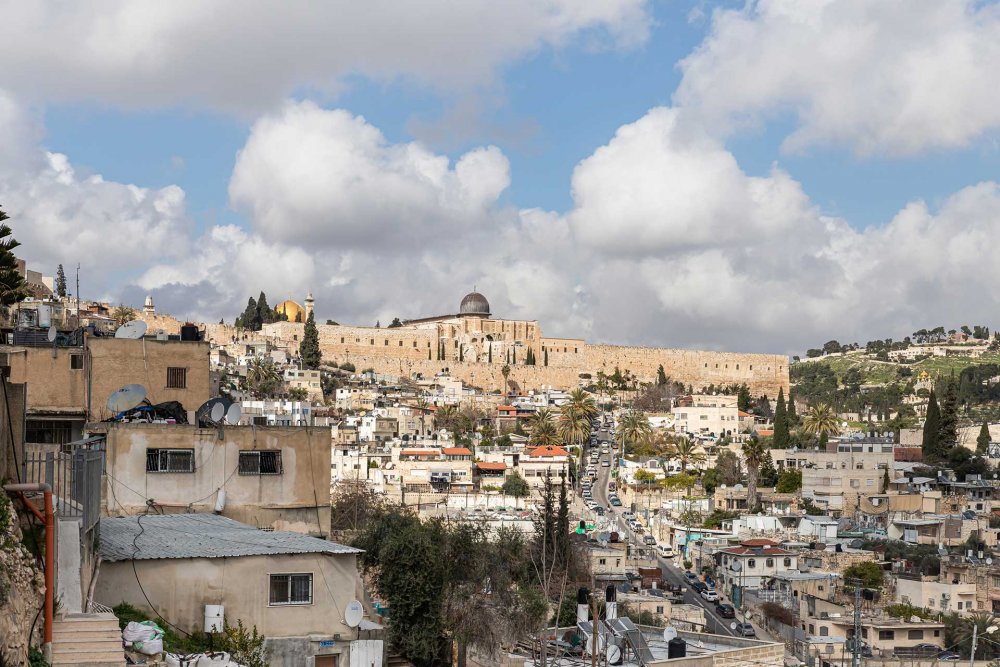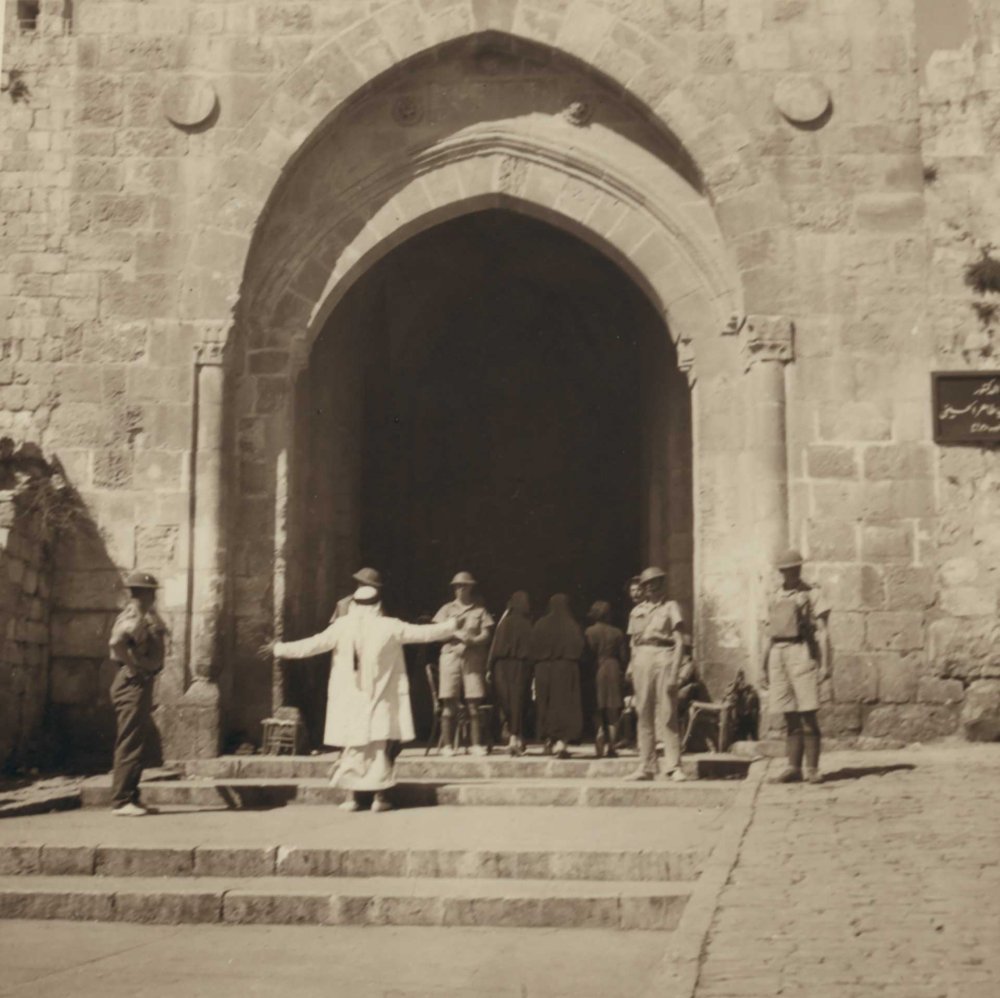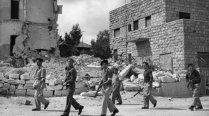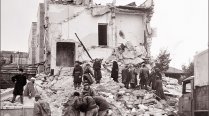Introduction
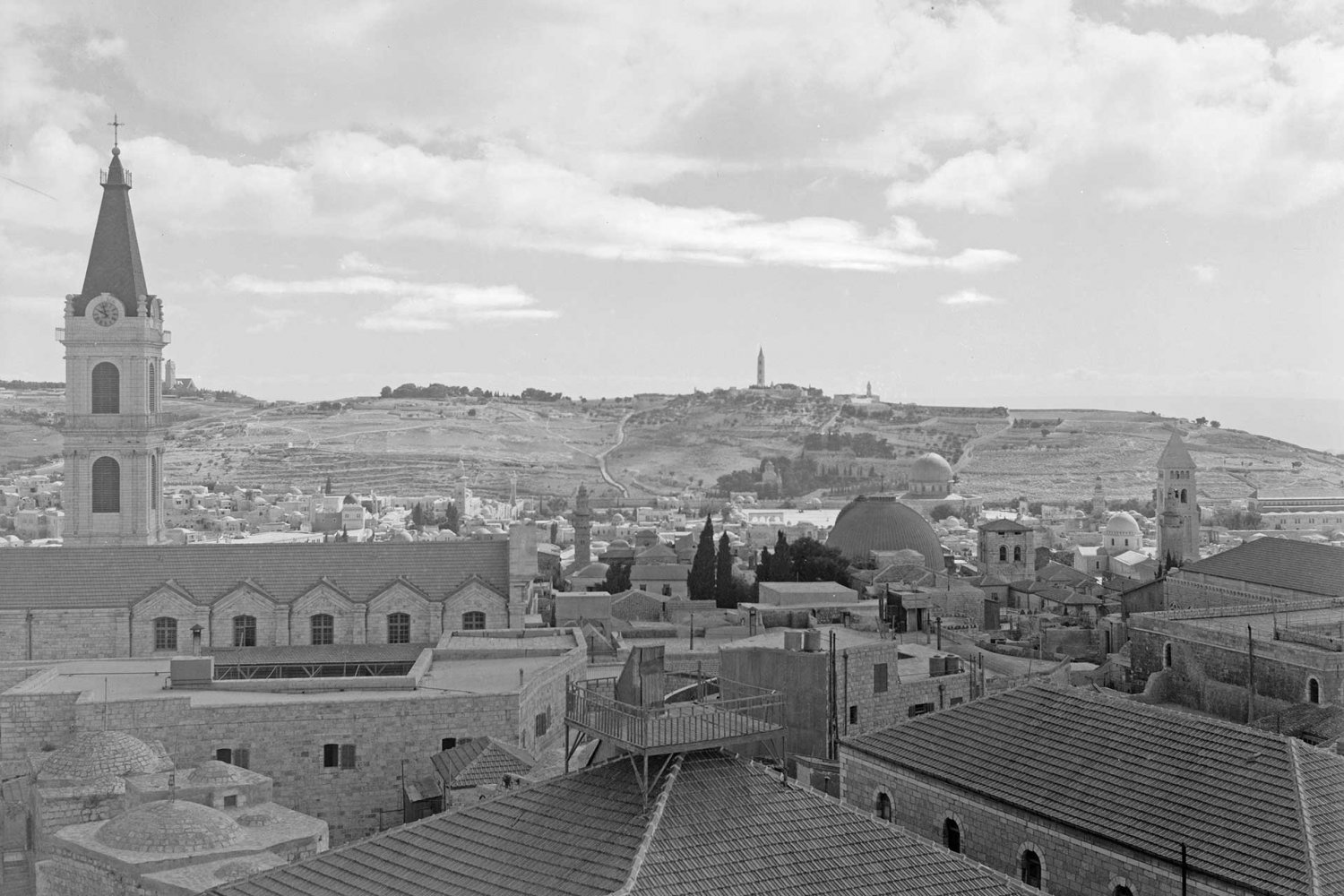
Credit:
HUM Images/Contributor via Getty Images
Issa Boullata and the Childhood Memories of Jerusalem That Never Faded
Snapshot
Excerpted from Issa J. Boullata, The Bells of Memory: A Palestinian Boyhood in Jerusalem (Westmount, Quebec: Linda Leith Publishing, 2014).
In the preface to this memoir covering his formative years growing up in Jerusalem, Issa J. Boullata explains what prompted him to write:
Now an octogenarian living away from my beloved hometown for over forty years and seeing that it is still glowing in my memory as if I were currently living in it, I thought of putting together my writings about it and about my boyhood in it. . . . [The chapters] speak of the city I have loved infinitely and will love until the end of my days.
The excerpts from the book describe the author’s recollections of formative places and moments of his childhood: his family home, his excitement at attending school and learning to read, the teachers who instilled in him a love of learning which would become his calling, his recollections of the revolt of 1936, and the derailment of his plans for his future by the Nakba. These excerpts are reprinted with the kind permission of the publisher and the Estate of Issa J. Boullata.
From Chapter I, “Roots in Jerusalem” (pp. 2–3)
I am deeply rooted in Jerusalem . . .
No, I am not referring to this rootedness in ancient history, important and real as it is; . . . I am rather referring to the fact that I am personally rooted in Jerusalem because of my own life experiences and my own memories, and because of my family lore that has been part of my culture and identity since childhood . . .
Of the many stories about my grandfather [Issa Hanna Boullata] that they told and others confirmed was that he was a master mason who, in the late nineteenth century and the early twentieth century, built monumental edifices still standing in the Old City of Jerusalem, notably the colossal school of Mar Mitri next to the Greek Orthodox convent as well as the shopping complex of Dabbaghah next to the Church of the Holy Sepulchre. The latter, also known as Suq Ephtimios, is a centre consisting of one hundred and fifty-two shops intersected by cobbled public roads. It has several gateways, the most ornate of which is the triple archway nearest to the Church of the Holy Sepulchre. In the middle of this shopping complex is a circular waterworks construction with marble basins in several tiers which, at one time, used to be a beautiful and refreshing sight when the fountain operated. I have never seen it operating but, as a child, I liked to go around it to look with intent pleasure at the low glass stalls under awnings that surrounded it. These were the stalls of the Bukhara mystics of the Naqshabandi Order in Jerusalem, who sold trinkets of all kinds for a living and often sharpened knives, scissors, and axes on rotating spark-producing grindstones that always fascinated children. As a little boy, I used to buy marbles and spinning tops from them; and as an adolescent, razor blades, penknives, and other inexpensive needs.
Above the shops, on the west side of the complex, was St. John’s Hospice which used to house Christian pilgrims to the Holy Land in earlier times. After 1948, rooms in it were rented to Palestinian refugees at a low rent charged by the Orthodox Patriarchate of Jerusalem, which owned the complex as a church trust, among many other properties it still holds in Jerusalem and the rest of Palestine. After 1967, as Jewish settler groups established and expanded their settlements in the West Bank and the Gaza Strip, they turned their attention in the early 1980s to the Old City of Jerusalem. In April of 1990, the Ateret Cohanim settler group occupied St. John’s Hospice, claiming the property was sold to them by an Armenian tenant via a Panamanian company, as the Jerusalem Post reported on April 17, 1990. A physical confrontation resulted when the Greek Orthodox Patriarch and his supporters tried in vain to evict the settlers and retake control of the hospice, and in the hands of the Israeli courts the matter has led nowhere. Not only is the formerly playful fountain of my grandfather silent today, but the stalls of the Bukhara mystics are gone, and St. John’s Hospice continues to be forcibly occupied.
From Chapter II, “The Lady Teachers” (pp. 9–10, 16–17)
Called the Thawri Elementary School for Boys and Girls, it was located on the top of the mountain in the middle of the Thawri neighbourhood, commonly called Tori or Abu Tor in colloquial speech. Situated in the southern part of Jerusalem and separated from the walled Old City by a hill and by a valley leading eastward to the village of Silwan, this Arab residential neighbourhood had modern buildings and its inhabitants were mostly Muslims. My father had moved our family there from Upper Baq‘a, a modern Arab residential neighbourhood inhabited mainly by Christians and situated in the southwestern part of Jerusalem. He considered our home there too far from the only government school in the area, the Thawri School; so he decided to move from it and rent an apartment for our family that would be closer to the school, to which I and later my younger siblings went.
The school consisted of four classes: the kindergarten and three elementary classes; the four classes were housed in rooms on the second floor around a hall, which also had a teachers’ powder room and a small kitchen where the teachers could make tea or coffee and warm up their lunch. Since the school building was constructed on an incline, the first floor below had only two large rooms: one was used as a refectory for pupils who brought their lunch with them, and the other as a storage room. The latter room was commonly called “The Mice House” and was reputed to be the dreary place to which badly behaving pupils were temporarily consigned for punishment, although I never saw either pupils or mice in it. The schoolyard was not too large but sufficiently comfortable for the small student body to play in. It had a wall of rough, un-cemented stones on three sides, a wooden gate for the pupils’ entrance, two huge and shady trees, and separate lavatories for boys and girls at the far end. Behind the school on the opposite side of this yard was the lovely garden visible from the kindergarten room, but it was for the pleasure of the staff only. It too was enclosed by a wall on three sides, it had a small fountain and pond in the middle, several footpaths and flower beds, a number of shady trees and benches, and a gate at the far end.
The school had four lady teachers: Sitt Alexandra, the headmistress and kindergarten homeroom teacher and Sitt Nigar, Sitt Asma, and Sitt Wasila, each of whom was responsible for one of the three elementary classes. The pupils were mostly Muslim; as for the teachers, Sitt Alexandra and Sitt Wasila were Christian, and Sitt Nigar and Sitt Asma were Muslim. The teachers had all been trained professionally at the Teachers’ Training College in Ramallah and had acquired the latest teaching and pedagogic methods of modern education offered there by the Department of Education of the British Mandate of Palestine.
My kindergarten year was a pleasant introduction to my later academic formation. I do not remember its details but I know that, by playful instruction, I came to learn how to read, how to add and subtract, how to draw and write in pencil, how to make figures in plastic dough, and how to sing a few songs with my classmates.
. . .
The three school years after kindergarten were as pleasant and educational as my kindergarten year at the Thawri School, and my knowledge continued to develop incrementally. . . .
I also learned to write Arabic well, and my handwriting was particularly neat and beautiful using the graded calligraphy workbook series of calligrapher Mustafa al-Shihabi, with a model top line by him on each page to be imitated. I also learned the four processes of arithmetic, some basic data of geography and history, and important information on hygiene and cleanliness. Above all, I learned to be a good member of a small society and an example to my younger siblings, who joined the school in later years.
One of the important things I learned was to use my hands to make beautiful and useful things. At the beginning it was making figures with plastic play dough in kindergarten. My imagination was given free rein to make what I liked and, to go by what my mistress Sitt Alexandra told my parents, I was so creative that I made things the other pupils never thought of, such as spoons and forks and kitchen utensils; but I also made figures of animals, birds, and people in different professions. . . . In the higher elementary classes, I also learned to knit and to embroider in the crafts hour.
. . .
But imagine my great surprise and delight, one day, on seeing the author of my Arabic reader, Khalil Sakakini himself, in my classroom. He was paying an official visit to my school as the government’s Inspector of Arabic. He was a strongly built man, tall and portly and awe-inspiring. He wore a red fez and had a commanding and dignified presence. His eyes shone brilliantly with intelligence, an encouraging smile never abandoned his lips, and he spoke in classical Arabic.
I am rather referring to the fact that I am personally rooted in Jerusalem because of my own life experiences and my own memories, and because of my family lore that has been part of my culture and identity since childhood . . .
I admired Khalil Sakakini and wanted to be like him when I grew up, a good teacher and educator with an excellent knowledge of Arabic language and literature. I later learned much more about him. He was the author of more than a dozen books, and he had been an indomitable figure whose participation in Palestinian politics in Ottoman and British times often led to his imprisonment. He always cherished freedom and dignity and truth and justice as essential human values worth struggling for. He had a good sense of humour, was interested in music and singing, played the violin, and liked good food and a hearty life enhanced by physical exercise and sports. As a young man he had emigrated to the US but returned to live in his beloved homeland. At different times of his life, he was a member of a variety of literary circles in Jerusalem, which brought the best Arab intellectuals and writers of the day together for informal conversations, which were a pleasure to attend. He had friends among the writers of other parts of the Arab world and was in contact with them; and he was elected as a member of the prestigious Academy of the Arabic Language in Cairo.
From Chapter III, “Turbulent Times” (pp. 24–25, 27–28, 29–30)
I remember my second childhood home better than my first because I was older when we moved to it in 1934, when I was about five years old. It was a rented apartment on the ground floor of a four-apartment building with two floors, and was owned by Shaykh ‘Abd al-Bari Barakat. It was in the al-Thawri neighbourhood, an Arab residential quarter mostly owned and inhabited by middle-class Muslims.
From the doorstep of my home I could see, across the valley, parts of the Old City of Jerusalem to the north that were not hidden by the intervening hill, Mount Zion, on which stood Prophet David’s neighbourhood, al-Nabi Dawood, one of the oldest Arab neighbourhoods outside the city walls of Jerusalem. Across the valley I could see Jaffa Gate, known in Arabic as Bab al-Khalil (Hebron Gate) because it leads to the city of al-Khalil (Hebron) to the south, past the town of Bethlehem; it also leads to Yafa (Jaffa) to the west, past the town of Ramleh, hence its name Jaffa Gate in English. From my home I could also see, across the valley, the al-Aqsa Mosque and its dome in the southeastern corner of the Old City and, within its city walls . . .
My parents tried to shield us from any feelings of insecurity at home. And although, as children in the 1930s, my siblings and I understood little of what was really going on, we sensed something was amiss. The truth was that there was an Arab armed rebellion in the country against the British Mandate. Arab rebels occasionally roamed the streets of our neighbourhood with their weapons, especially in the dark of night; the British army was more visible in the country with now larger numbers, ominous weaponry, and armoured cars; and the Palestine police force under the organization of the British mandatory government was more alert to new civic duties of public security, crowd control, and people’s movements. The Arab turbulence came to a head in the Rebellion of 1936–1939, which spread all over Palestine, beginning in April 1936 with a general strike that paralyzed the country for six months.
During the strike, all Arab shops were closed, all Arab buses and trucks stopped running, all Arab workers refrained from unloading shipments of imports and loading cargoes for export, and all Arab trade came to a standstill. The Palestinians demanded that the British suspend Jewish immigration and begin negotiations to form a national government for Palestine. The trains, however, continued to run because they were under the administration of the British Mandatory government, and all Arab employees of the government—like my father—continued to fulfill their work obligations lest they lose their jobs to Jewish employees, but they privately contributed a percentage of their salaries to the strike fund and national resistance. My father had to go five miles on foot to perform his daily duties at the Telegraph Office, my school teachers at the government school continued their usual teaching and I my usual learning; but the atmosphere everywhere was tense.
Meanwhile, my mother had to provide food for the family, and provisions were running low—mainly rice, bulgur, lentils, beans, chickpeas, flour, olive oil, ghee, salt, onions, garlic, pickled olives, cheese, sugar, tea, coffee, and other storable commodities like canned sardines and corned beef. Once in a while, a butcher appeared in our neighbourhood, slaughtered a sheep clandestinely deep in Karm Karimeh, a grove of olive trees on the incline by the main road next to our home, hung the carcass on a tree, and was swarmed by neighbours wanting to buy fresh meat; he had to finish his business quickly before he was discovered by the roving members of the “national committees” who enforced the strike.
Women from the villages surrounding Jerusalem appeared from time to time carrying on their heads baskets loaded with fruits and vegetables that they had grown but could not take to sell at the closed markets. They brought them furtively to the doorstep of buyers in our neighbourhood and elsewhere to sell, though fearing their goods might be mashed underfoot by the strike enforcers, if they were discovered. Similarly, village women went around to the homes to sell the milk and butter of their cows or goats. My mother, like all the neighbours, took advantage of all these opportunities during the six month strike and kept her family well fed. No member of our family ever missed a hearty meal or went hungry to bed.
The strike lasted until October 1936, longer than any other general strike in the Middle East or Europe.
. . .
At the height of the rebellion, the Old City of Jerusalem was totally in the hands of the rebels for five days in October 1938 until the British forces took it back after fierce fighting with the rebels in its alleys and lanes. From my home in al-Thawri, I could see small British reconnaissance airplanes repeatedly flying over the Old City of Jerusalem pinpointing the centres of rebel resistance in it by sending down signals of silver flashes that descended like shooting starts to direct and guide the British forces on the ground in the maze of the old city.
. . .
There was a house search by British soldiers in our neighbourhood. It was not the first, nor would it be the last, and they were all conducted without a search warrant. A number of armed British soldiers entered our home and went into every room, opening wardrobes and drawers, emptying their contents on the floor and rummaging through them; they overturned furniture and fumbled mattresses and pillows, looking for hidden arms and ammunition. In the kitchen they ransacked my mother’s provisions, pouring out her neatly organized supplies and mixing their contents. . . . The government had made a new law that allowed them to demolish a home in which arms were discovered or ammunition was found, and to arrest its tenant. We children were afraid at the sight of armed soldiers in our home, but my mother was not, or pretended she was not—perhaps to give us reassurance.
My father was away at work most of the times we had those searches. But one time, he was shaving in the morning before going to work, and the British soldiers took him away in his pajamas with other neighbourhood men; they did not let him continue shaving or even wipe the shaving cream foam off his face. With the other men, he was taken to the parking lot of the nearby Government Printing Press where they were all subjected to an investigation. While each man was being interrogated separately by a British officer sitting at a table, an informant hidden in the back of a canvas-covered, British military truck was watching through a hole in the canvas and giving an agreed-upon clink to signal whether the person interrogated was a rebel sympathizer or was in any way connected with the national rebellion. In the end, a few men were detained for further investigation and the others were let go, including my father, who related to us what had happened when he returned home; he then continued his shaving, and went to work about two hours late.
. . .
When there was no curfew, British soldiers at many checkpoints in the city stopped and frisked people. They were particularly suspicious of men who wore the Arab headdress, that is, the head kerchief and black rope (the kuffiyeh and ‘iqal); for this headdress was what the rebels wore, and the British aimed at isolating them, limiting their movements among the population, and eventually catching them. It was at this juncture that the leaders of the national movement issued orders that all Palestinian men should wear the Arab headdress to confuse the British. My father, like many civilian Arabs in the city, used to wear a red fez; now he and all Palestinian men took to wearing the Arab headdress. This made his solitary walk to and from work during curfews, especially in the dark, all the more problematic, and he had to keep his curfew pass and identity card to show to British soldiers screaming at him to halt or be shot.
From Chapter VII, “Al-Nakba: The 1948 Catastrophe of Palestine” (pp. 73, 80–81, 84)
I was nineteen years old when the Nakba occurred. I had graduated from the Collège des Frère on July 1st, 1947, and had been accepted for a British Mandate government job as an accountant of the Department of Prisons at the Central Prison in Jerusalem. At the same time, I had been admitted as a student in the Law School run in Jerusalem by the Law Council of Palestine, and I had regularly begun to attend its evening classes given by British and Palestinian (Arab and Jewish) professors. I was contemplating a career in the legal profession and was full of hope that a good life was ahead of me. This hope was normal and not a presumptuous expectation; I was a human being looking forward to achieving my inalienable right to the pursuit of happiness.
Yet a Palestinian Arab under the British who had, in the Balfour Declaration of 1917, promised to view with favour “the establishment in Palestine of a national home for the Jewish people” was not expected, it seems, to have this inalienable right.
When I graduated from high school in 1947, the political atmosphere in Palestine was tense. It gradually deteriorated into violent acts committed by Zionist and Palestinian groups. The British were increasingly losing control. I was aware, on the whole, that the Palestinian leadership was in disarray. Other than negativism, I observed that its politicians did not have well-planned policies vis-à-vis the British or the United Nations. Its military activities lacked coordination and dependable weapon supplies. The seven states of the newly formed Arab League, which were supposed to help the Palestinians, were not in a better condition.
I was aware, too, that the Jewish political leadership was organized and had clear-cut goals. Its military activities had strategic aims, were well supplied with weapons by international Jewish organizations and friendly Western countries, and used all possible tactics to achieve their ends, including terrorizing the Arab civilian population and causing them—sometimes compelling them—to evacuate their homes and abandon their lands and properties . . .
The Partition Plan voted for by thirty-three countries of the United Nations was a triumph for the Zionists. I remember the jubilation of the Jews in the streets of Jerusalem on this occasion, particularly Ben Yehuda Street and Jaffa Road, where Jewish people sang and danced publicly, and wine was offered free to everyone until a late hour. Arab anger intensified, and a three-day strike in Palestine was declared on December 2nd protesting the United Nations resolution . . . The Jews and the Arabs in Palestine were at daggers drawn, and a sort of civil war was at hand.
The British attempt to control Jerusalem by dividing it into different zones, with restricted movement from one to the other and with checkpoints between them manned by police, was not successful in restraining the opponents, each of whom was attempting to dominate as much of the city and the country as possible before the British withdrew. The Jewish military groups prepared themselves, and on November 30th the Haganah called up all Jews in Palestine between the ages of seventeen and twenty-five to register for military service; the Haganah also succeeded in obtaining arms from Czechoslovakia to support its Plan Gimmel, which aimed to destabilize the Palestinian population and occupy strategic positions in Jerusalem and other locations in Palestine. The Irgun attacked Arab residential areas in Jerusalem, Jaffa, and Haifa; and Palestinians were killed at Herod’s Gate in Jerusalem, at Haifa’s oil refinery, and elsewhere. The Haganah blew up the Semiramis Hotel in the Jerusalem residential area of Qatamon, killing twenty civilians. As a passerby, I miraculously escaped from dying in an explosion set by the Irgun in the area outside of Jaffa Gate on January 7, 1948, in which twenty-five Palestinian civilians were killed and many were injured. Like all Palestinian Arabs, I was a victim of events and of the decisions being made by those in authority.
. . .
As the Nakba was unfolding and wreaking havoc in Palestine, I was living with my parents and siblings in our home in the Old City of Jerusalem, in the neighbourhood inside the city walls at Jaffa Gate.
. . .
My family and I took shelter in the windowless room on the first floor of our house one night when the fighting was at its worst; we could hear the Hebrew shouts of the attackers outside Jaffa Gate encouraging one another to advance, and we winced at the explosions of mortar projectiles hurled by them as they shelled our neighbourhood. The next day, we found out that one mortar shell had hit the big dome of the Holy Sepulchre, causing a fire, that several persons were injured and killed in their homes, and that many dead bodies of Jewish attackers were strewn in the open area outside Jaffa Gate—and that the Old City of Jerusalem remained in Palestinian hands.
. . .
And there are still more thousands who own no land and, like me, have not even lost their homes. Yet they feel the injustice resulting from the Nakba as strongly and as deeply as all the other Palestinians because, like them, they have lost the dignity of having a country of their own, of being citizens of their own state, and of living a life of free human beings with all the inalienable rights that ought to be theirs. They all suffer and remember.

